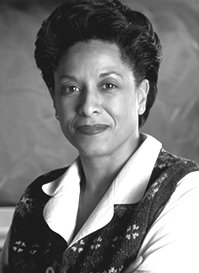
The National Council for Accreditation of Teacher Education (known broadly as NCATE, pronounced “en kate”) was launched in 1954 by a coalition of professional organizations from across the education community. Previously, teacher-training programs had been accredited by states, regional accrediting bodies, or an association of teacher colleges, each equipped with its own benchmarks and methods of evaluation. NCATE aimed to professionalize teaching by establishing national standards for accreditation.
Support for NCATE’s mission runs deep within the education establishment. Five of education’s most powerful organizations jointly founded NCATE: the National Education Association and four associations representing education schools, state education officials, and school boards. Today, NCATE has 33 member organizations, including the two national teachers unions; the major subject-based associations in English, math, social studies, and science; and policy and administrator groups (see Figure 1).
Despite NCATE’s having such a strong imprimatur, only 540 of the nation’s roughly 1,300 teacher-preparation programs have received NCATE accreditation. The scene is changing quickly, though. In just the past three years, 100 training programs have become accredited, and another 100 or so are currently under review for initial accreditation. Foundations are also increasingly enthusiastic about NCATE’s mission, having contributed more than $10 million since 1990. NCATE president Arthur E. Wise attributes this growth to “the new climate of accountability and the desire of institutions to be able to demonstrate that they have met rigorous national standards.” NCATE’s legitimacy as an accrediting body is recognized by the U.S. Department of Education and the private Council for Higher Education Accreditation, a nationally recognized advocate for voluntary accreditation and quality assurance.
This only begins to describe NCATE’s growing influence. It has yet to become education’s equivalent of the American Bar Association, which effectively controls entry into the legal profession, but it now accredits institutions that train more than 70 percent of the nation’s teachers. Eight states mandate NCATE accreditation for teacher-training programs, and NCATE has formal partnerships with 46 states for conducting joint reviews of schools of education. All joint reviews are based on NCATE’s accreditation standards, essentially making NCATE’s standards the benchmark for teacher preparation across the nation. The most visible sign of NCATE’s expanding reach may be U.S. News & World Report‘s decision, as of 2002, to list whether a school is accredited by NCATE in its annual ranking of the Best Graduate Schools in Education.
NCATE’s path to prominence reflects an across-the-board push to professionalize teaching along lines similar to medicine and law. Together with sister organizations like the National Board for Professional Teaching Standards and the National Commission on Teaching & America’s Future, NCATE is developing increasingly symbiotic relationships with state-level licensing boards–relationships that allow these organizations to push forward their agenda of increased training requirements, tougher licensing exams, and the higher pay to match. The question is whether the mere trappings of professionalism will actually improve the teaching profession.
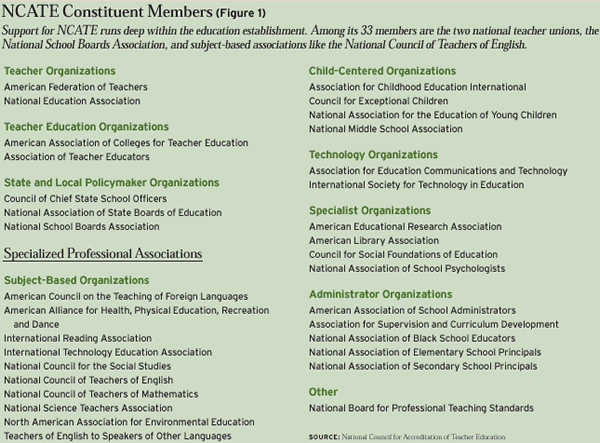
The Process
NCATE claims to be improving the quality of teacher education through its stringent standards and rigorous system of evaluation. A look at the process, however, reveals a focus on the attributes of a given program more than on its success in producing good teachers (see Figure 2).
How does a department, college, or school obtain NCATE accreditation? First, two to three years before an accreditation visit, the college becomes a precandidate for NCATE accreditation. Precandidates must pay an annual fee of $1,615 and submit an annual report to NCATE. Three semesters before the accreditation visit, the college must meet nine preconditions. These preconditions include the submission of numerous documents and a “conceptual framework” that specifies the program’s mission, philosophy, performance expectations for candidates, and candidate assessment system. Depending on the nature of NCATE’s partnership with the state, the college may also be required to produce detailed reports (limited to 140 pages each) on each of its education programs. Such reports must be approved by NCATE’s specialty associations. Once all preconditions are met, NCATE establishes formal candidacy for the college, and the accreditation visit is usually conducted one to two years later. Two months before the accreditation visit, the college prepares and delivers an extensive report on how it meets NCATE’s standards.

Three to eight members of the NCATE Board of Examiners then conduct a five-day site visit. These visitors are part of NCATE’s pool of about 450 examiners, comprising teachers, professors, and representatives from NCATE’s policymaking and specialty organizations. They tend to do about two visits a year. Examiners are given a week of training when first hired and are evaluated by their peers and by the institutions at the conclusion of each visit.
The site team interviews faculty, students, staff, graduates, and employers, gathers data, and reports its findings. The college under review is permitted to write a response. All materials are then sent to NCATE’s accreditation board for review. The board meets twice a year for a week at a time, and it rules on about 120 accreditation requests each year. The board is composed of 33 members from NCATE’s constituent organizations–one-third coming from teacher organizations, another third from teacher-education organizations, the rest from policy and school specialist organizations.
Accredited departments or colleges pay an annual accreditation fee of between $1,615 and $3,095. Accredited institutions that are not affiliated with the American Association of Colleges for Teacher Education must pay an additional annual “sustaining fee” of between $745 and $1,245. Accreditation visits occur every five years and cost between $3,000 and $8,000. Other expenses involved in preparing the required materials (for instance, faculty time and clerical support) are borne by the institution.
NCATE’s 33 member organizations also pay annual dues ranging from $12,000 to $250,000. The dues structure is based on the number of members an organization names to the NCATE policy boards. In return for their dues, the organizations are given the opportunity to help develop and implement NCATE’s standards. Revenue is also generated by the recently opened “NCATE Store” on the NCATE website, which sells golf shirts, pens, mugs, mousepads, and lapel pins with the NCATE logo.
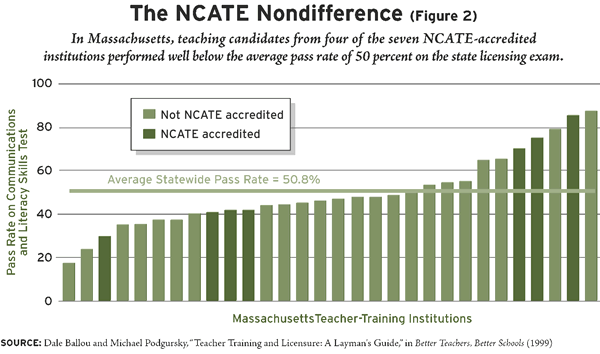
The NCATE Standards
NCATE revises its accreditation standards every five years. The most recent revision, completed in the fall of 2000, was promoted by NCATE as having aligned its standards with the broader movement toward accountability and outcome standards. NCATE president Wise has hailed this revision as “a radical reform of our accreditation process. This is a revolutionary approach to accreditation because NCATE used to measure what colleges offered their students. Now we’re focusing on outcomes.”
In the past, NCATE claims, its standards focused on inputs: the quality of a program’s curriculum and resources. Now, NCATE insists, “It is no longer acceptable for the candidates simply to have been exposed to certain topics in the curriculum. . . . Institutions must demonstrate that candidates know their subject and how to teach it effectively.”
Let’s examine these claims through a review of the six standards:
• Candidate Knowledge, Skills, and Dispositions. Graduates are to demonstrate “the content, pedagogical, and professional knowledge, skills, and dispositions necessary to help all students learn” in a manner consistent with professional, state, and institutional standards. Departments or colleges are to document their performance using their own assessment data and external measures such as candidates’ performance on state licensing exams. In addition to the 6 NCATE professional standards, NCATE has approved 18 sets of program standards that have been developed by its constituent specialty associations, such as the National Council of Teachers of Mathematics and the National Council of Teachers of English. NCATE expects programs within a college to be congruent with the associations’ standards. Yet there is widespread concern that these associations have developed standards based on normative conceptions of good pedagogy and curricula that have not necessarily been shown to improve student achievement. For experienced teachers in graduate programs, NCATE suggests that they work to meet the requirements of the National Board for Professional Teaching Standards for advanced certification. However, researchers have yet to determine whether board certification affects student achievement.
• Assessment. Colleges or departments are to engage in extensive efforts to collect and analyze data on applicants’ qualifications, candidate and graduate performance, and unit operations. They are to use this data for continuing program evaluation and improvement. The rigor implied in this standard is admirable. Unfortunately, the professional, state, and institutional standards against which programs are asked to measure themselves have not typically been validated with equal rigor.
• Field Experience. Colleges or departments and the local schools with which they form partnerships are to provide field experiences that help teacher candidates to develop the knowledge, skills, and dispositions needed to help all students learn. NCATE lists many possible measures for this standard and requires that “all candidates participate in field experiences or clinical practice that include students with exceptionalities and students from diverse ethnic, racial, gender, and socioeconomic groups.”
• Diversity. The discussions of “diversity” in four of the other five standards are only a warm-up for this standard. Programs are charged with ensuring that candidates work with “diverse” higher education and school faculty, peers, and students, and must demonstrate “good-faith efforts” to admit candidates and hire faculty from diverse cultural backgrounds. Candidates must learn to develop “a classroom and school climate that values diversity . . . [an awareness] of different teaching and learning styles shaped by cultural influences . . . dispositions that respect and value differences” and “skills for working in diverse settings.” Candidates are also required to learn to teach from “multicultural and global perspectives” and program faculty are to design learning experiences that help candidates to “process diversity concepts.”
• Faculty Qualities. Faculty are to be “qualified,” model “best professional practices,” engage in self-assessment, and collaborate with practitioners and disciplinary colleagues. NCATE requires data on faculty degrees held, research productivity, and teaching evaluations. NCATE standards for faculty include that members “integrate diversity and technology throughout their teaching” and “introduce candidates to research and good practice that counter myths and misperceptions about teaching and learning.”
• Unit Governance and Resources. The last standard requires units to have leadership, authority, budget, personnel, facilities, and resources adequate for preparing candidates to meet professional, state, and institutional standards.
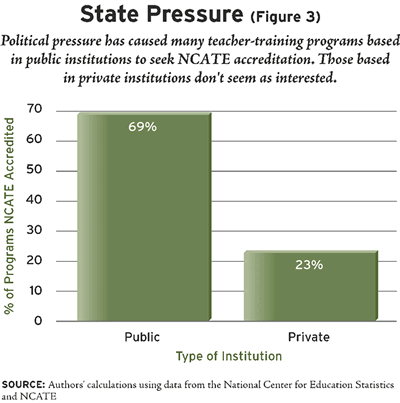
It should be clear that the standards NCATE uses to evaluate teacher-training programs are primarily input-driven: the main measures of a program’s quality are such things as the degrees held by faculty, program resources, and curricular content. Wise describes these criteria as “selected elements of process that are embedded in our standards. They emphasize some things that our committee and community believe are particularly important: like diversity, the use of technology, and the availability of necessary resources.” He argues that an accreditation model based strictly on outcomes is problematic “because, paradoxically, if you only hold institutions accountable for results, you let those with good inputs off the hook.” In other words, focusing solely on outcomes lets the Harvards of the world breeze by on the strength of their students’ natural abilities, while programs with weaker students are punished unfairly regardless of the value they are adding.
Wise’s point is reasonable, but it highlights the ambiguity at the heart of NCATE’s mission. As Wise himself notes, accreditation is a “pass/fail” proposition intended only to ensure that an institution is meeting certain standards–not to guarantee that they train teachers to be effective.
One way in which NCATE attempts to demonstrate its effectiveness is by citing the fact that the three states that required NCATE accreditation for all schools of education during the 1980s–Arkansas, North Carolina, and West Virginia–experienced greater than average increases in student achievement on the NAEP assessments during the 1990s. But many factors can influence a state’s educational performance, from changes in state policies to changes in their demographic makeup, making it extraordinarily difficult for researchers to isolate any one cause for an increase in achievement.
The piece of evidence cited most frequently by NCATE measured how teacher candidates fared between 1995 and 1997 on the Educational Testing Service’s PRAXIS II licensing exams for teachers. NCATE trumpets the fact that graduates of NCATE-accredited schools fared 7 percentage points better than did graduates of non-NCATE programs. Yet economists Dale Ballou and Michael Podgursky identified significant methodological flaws in this study. Moreover, their analyses of graduates of NCATE and of non-NCATE programs found little evidence of differences between the two groups (see Figure 2). School administrators seeking to hire new teachers cannot be confident that graduates of NCATE-accredited institutions are likely to be better teachers than other applicants.
Absent empirical evidence that teachers trained “the NCATE way” serve students more effectively than other teachers, the value of NCATE accreditation is a matter of faith. If one questions the value or objectivity of NCATE’s standards, the process can seem like a mere bureaucratic mechanism that endorses institutions that train teachers in accord with certain pedagogical and curricular precepts. This problem is particularly acute because NCATE’s subject-matter standards were drafted by its constituent specialty associations–and those groups, like the National Council of Teachers of Mathematics and the National Council of Teachers of English, have a track record of promoting methods of instruction whose value has not been well established.
Thus we come to the tension at the heart of teacher preparation. After all, efforts to pin down teacher educators regarding “essential” knowledge or skills illuminate the slipperiness of our conception of the competent teacher. The NCATE standards document declares, “The profession has reached a consensus about the knowledge and skills a teacher needs to help P-12 students learn. That consensus forms the basis for the NCATE standards.” However, this consensus has not been embraced by many other education stakeholders. As noted by Frank B. Murray, president of the Teacher Education Accreditation Council (TEAC), a rival accrediting agency, even among education scholars and practitioners, “there is still no consensus . . . about what would constitute educational malpractice.”

As a result, NCATE’s ostensibly outcome-based standards lean heavily on inputs and on confirming the presence of practices that it deems desirable. However, determining “best practices” in teaching is far from a straightforward process, as even professionals disagree over how an effective teacher approaches bilingual education, homework, student testing, student spelling and grammar, student-directed learning, “multicultural” lessons, discipline, desk arrangement, scientific inquiry, and so on. Moreover, prominent voices in teacher preparation continue to question whether clear-cut measures of student outcomes–such as graduation rates or test performance–are legitimate measures of educational performance.
Without widespread agreement on what good teachers need to know and be able to do, and given the skepticism among professional educators about the fairness or value of standardized assessments, NCATE has little leeway for assessing outcomes without inspiring controversy. As a result, the dean of a nationally ranked school of education notes, “NCATE focuses on things like the number of books in our library and the number of degrees among our faculty rather than what we actually do.”
Some critics have charged that NCATE’s focus on procedures, resources, and extensive documentation is a significant burden for smaller programs. Richard Ekman, president of the Council of Independent Colleges, says, “NCATE calls for lots and lots of methods courses that go well beyond what small colleges can offer. Yet the graduates from these colleges come out with good, solid content majors . . . which is very much in demand by the school districts doing the hiring.” NCATE rejects such criticisms, responding that “all types of institutions can and do meet professional accreditation expectations” and noting that 200 of its 540 accredited institutions are private, independent liberal arts colleges. However, our analysis of NCATE-accredited institutions reveals some significant patterns. Only 23 percent of education programs at private institutions are NCATE-accredited, compared with 69 percent of the education programs at public institutions (see Figure 3). For both public and private institutions, the frequency of NCATE accreditation increases with the size of the institution. Only 22 percent of small private institutions and 63 percent of small public institutions possess NCATE accreditation, compared with 44 percent of large private institutions and 74 percent of large public institutions (see Figure 4).
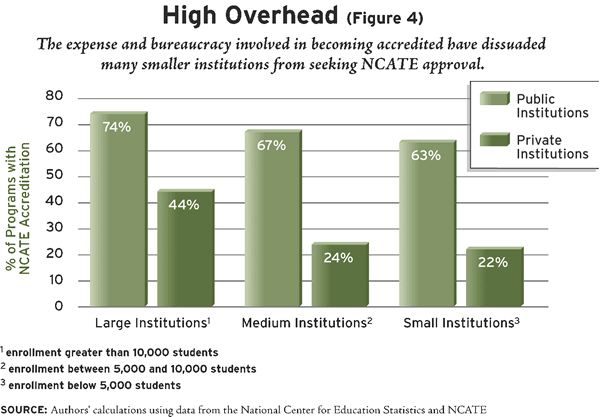
Even larger institutions report that the NCATE process is burdensome, and administrators at leading universities have questioned the value of participating in the NCATE system. The dean of a nationally ranked, NCATE-accredited school of education told us: “The [NCATE] process was very time-consuming and expensive, to be sure. And I’m not entirely convinced that all that we were asked to do is necessary or really contributes to the quality of the program. We have more resources than most schools, so it was manageable. I’m not sure many schools could manage it.”
Another nationally ranked program stopped participating in the NCATE system because it was, in the words of a university official, “a labor-intensive and therefore expensive process from which we got very little new information. There were also conflicts between a few NCATE policies and those that our faculty had endorsed. A sense of exclusive or proprietary responsibility at NCATE was in conflict with a culture of shared responsibility for teacher education that we value and try to cultivate.”
Fourteen of the top 25 graduate schools of education, as ranked by U.S. News & World Report, are not accredited by NCATE (see Figure 5). Three of the 14 schools, including Columbia University’s Teachers College, are NCATE candidates or applicants. A Teachers College official remarked, “The state is forcing our hand” and indicated that the college would not be seeking NCATE accreditation in the absence of a new state mandate.
Colleges of education may attempt to use NCATE’s requirements as leverage for securing increased resources from university budgets. Karen Zumwalt, the former dean and now a professor at Teachers College, said that while the college’s pursuit of NCATE accreditation will involve “an incredible amount of work, hopefully, it will provide both the impetus for program improvement and for obtaining the needed institutional resources.” Moreover, some colleges that are not required to participate in the NCATE system may do so anyway out of a sense of duty–to offer symbolic support for the objectives of NCATE and its allies. The dean of another top-ranked school explained that “the primary reason” for the school’s participation in the NCATE system “is to support (and participate in) an important effort to professionalize teaching.”
An Alternative to NCATE
The recent emergence of the Teacher Education Accreditation Council (TEAC) has challenged the accreditation monopoly long enjoyed by NCATE. Incorporated in 1997, TEAC was created with help from presidents of small, independent colleges who thought that NCATE’s prescriptive standards favored larger schools and neglected program outputs.
TEAC has been recognized by the Council for Higher Education Accreditation since 2001, and it is seeking approval from the U.S. Department of Education. TEAC membership costs $2,000, and an accreditation audit costs $1,000. TEAC has received more than $2 million in external funding from organizations including the Olin Foundation, the Pew Charitable Trusts, and the Atlantic Philanthropies. Programs accredited by TEAC set their own standards within TEAC guidelines, using an accountability model similar to that used in charter schooling. TEAC accreditation audits focus on three quality principles: evidence of teacher candidate learning, evidence that the assessment of such learning is valid, and evidence of the program’s own continuous improvement and quality control.
Programs seeking accreditation prepare a “research monograph” in which they present evidence that they are meeting the standards of the three principles, using multiple outcome measures such as teacher candidates’ grades, scores on standardized entrance and exit exams and portfolios; community service data; and employer surveys. TEAC then audits the evidence to evaluate whether the program is preparing competent, caring, and qualified educators and decides whether to accredit the program.
Unlike NCATE, TEAC does not require applicants for accreditation to comply with standards developed by external organizations. Rather, TEAC requires that the standards selected by the accreditation candidate be based on research and lead to the preparation of competent, caring, and qualified teachers.
By allowing teacher-education faculty to select the standards and evidence by which they will be judged, TEAC permits a tight alignment of accountability measures and program goals. Such a process can enhance faculty commitment and is well suited to fostering productive self-evaluation and continuous improvement. Most promising, TEAC’s heavy emphasis on the obligation of teacher-education programs to produce convincing evidence in support of the claims they make about their own quality has the potential to enhance accountability in teacher education.

Conclusion
In a way, whether NCATE or another accrediting body attains a position of influence within teacher education is irrelevant; NCATE’s standards reflect the collective judgment of teachers, teacher educators, and their representatives, and at worst they will probably do no harm to the enterprise of teacher training. The real concern is that NCATE and its sister organizations will succeed in tightening their grip on entry to the teaching profession itself. Once NCATE convinces states that all teacher-training programs must be NCATE-accredited, it is easy to imagine states requiring that all teachers pass through NCATE-accredited programs. This is precisely what happened in fields like medicine and law.
But teaching is not medicine or law. While the curricula of accredited medical schools must instruct students in “the fundamental principles of medicine” and accredited law schools must impart the “basic principles of public and private law,” the essential and fundamental principles of teaching have yet to be established. Accredited medical school curricula must include specific content from a range of scientific disciplines. Similarly, in law, there is consensus on a specific body of knowledge that is to be acquired. By contrast, there is no consensus on a necessary skill set and knowledge base for teachers. No one debates whether doctors or lawyers should have to undergo professional training in a university or college environment, but there is still substantial debate over the very value of teacher-training programs.
Indeed, it is questionable whether any form of accreditation is useful or appropriate in a context of widespread disagreement about what skills, dispositions, and methods are essential to good teaching. If teacher preparation were deregulated and current programs stripped of their monopoly, competitive pressure might compel them to document their quality in useful and appropriate ways without the bureaucratic constraints or costs of accreditation.
In a nation marked by disagreement about what teachers need to know, what they ought to be able to do, and what dispositions they should have, the challenges of devising a sound accreditation system are mighty. Compared with NCATE’s standards, TEAC’s lack of direction risks appearing relativistic. Yet, at the very least, NCATE should not be granted de facto status as the accrediting body for teacher education. Whether TEAC or another alternative will prove more effective is not clear. What is clear, however, is that the goal of a quality teacher in every classroom is more likely to be met in a system where various models of quality control are tried, tested, and compared than in a world where NCATE’s constituent organizations are effectively crafting the standards for the pedagogy, curriculum, and practice of teacher education.
Sandra Vergari is an assistant professor of educational administration and policy at the University at Albany, State University of New York. Frederick M. Hess is an assistant professor of education and government at the University of Virginia and executive editor of Education Next.


